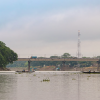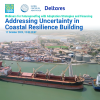Mainstreaming Water Adaptation
Join the adaption journey!
About Mainstreaming Water Adaptation
Mainstreaming water adaptation refers to the integration of adaptation measures to address water-related challenges into policies, plans, and programs across different sectors and levels of governance. The goal is to make water adaptation a standard practice that is integrated into decision-making processes and implemented systematically.
Water adaptation is becoming increasingly important due to the impacts of climate change on water resources. Rising temperatures, changing precipitation patterns, and more frequent extreme weather events are affecting water availability and quality, as well as increasing the risk of water-related disasters such as floods and droughts. Mainstreaming water adaptation is therefore crucial to ensure the sustainable management of water resources and to build resilience to climate change.
Overall, mainstreaming water adaptation is an important approach to ensure the sustainable management of water resources and build resilience to the impacts of climate change. It requires the collaboration of different sectors and levels of governance, as well as the involvement of stakeholders and the community. The adaptation journey points here are designed to be harmonizing and synergizing with the Paris Agreement for Climate Adaptation, the implementation of the Sendai Framework for Disaster Risk Reduction and the Sustainable Development Goals under the Agenda 2030.
Some key steps in mainstreaming water adaptation include:
Section
Get organized and strengthen institutional capacity
This means creating or assigning an organizational structure to coordinate and be responsible for the climate adaptation mainstreaming process. This can be done at various levels, at the national level, the regional, local level, as part of a local government and community organization. Establishing climate adaptation as a key consideration has shown to be important. This can be done by developing a strategy or integrating it into existing strategies. To ensure synergies with similar efforts, it is important to connect the organization with risk reduction and sustainable development processes. The institutional capacity needs to be built continuously at all levels and across sectors to provide an effective governance system.
Having organizational structure and clear processes in place is important as it ensures that the right expertise and competence are in place and induces ownership and internalization of the issues. This encourages a more profound and permanent change in the governance and day-to-day decision-making process. It is a critical component in other risk-related principles and frameworks. For example, organizing disaster resilience is also mentioned as part of the ten essentials for Making Cities Resilient by the UNDRR. Although locally led action and organization is crucial, a national level organization is essential because it ensures longer term vision and coordinated actions at strategic level, which can guide efforts at the other levels. Ideally, an adaptive organization is needed at multiple levels, that also communicate across levels, and exchange knowledge. Continuously building institutional capacity is crucial for realizing learning across levels and adaptation actions.
Resources:
-
A national level program is recommended to manage large deltas in the adaptation in deltas policy package.
-
A cross sectoral coordinating mandate for storm water management in this case study from Gothenburg, Sweden, is put in place to manage increasing rainfall.
Section
Assess climate risk
Climate risk assessments identify the likelihood of current and future climate hazards and their impacts. For an assessment to be done, up to date data on current and projected future climate related hazards and vulnerabilities is needed, which needs to be collected and maintained. These risk assessments need to be prepared in collaboration with other assessments of risks related to disasters and sustainable development. The risk assessments need to be a living document involving the relevant decision-makers, who also need to become aware of and understand the risks and how they are best addressed. Assessing risks can inform current and future investment decisions and prioritization of climate action.
Before beginning a risk assessment, the organization in charge needs to establish goals and aims of the assessment, carry out a stakeholder analysis, as well as make a review of existing resources and data. Risk assessments can be done at various levels; national, regional and local, and for different sectors and organizations. Several overviews exist of how to carry out a climate risk assessment.
Resources:
-
Cities are encouraged to publish their Climate Change Risk Assessment. The primary public reporting platform for cities is the CDP Cities, States and Regions Open Data Portal.
Section
Risk dialogues and strategising
When climate risks have been assessed for multiple actors and sectors, these need to be coordinated and prioritizations worked out. This requires dialogue and collaboration between multiple sectors and with an important role of decision-makers
After a risk assessment, there is a need for dialogue and strategizing to agree among several involved parties on how to best address the risks, prioritise among them and pool resources to address risks that go across budget lines.
The various risks need to be weighed against each other and different alternative measures compared. This dialogue can as such contribute to long term planning goals linked to risk reduction and sustainable development. These dialogues can also contribute to bridging siloes.
The Netherlands is implementing risk dialogues as a tool in spatial planning. You can read more about it here in English.

Section
Financing Adaptation
Sufficient financial resources and capacity to access available resources are critical for adaptation. Also, various financial mechanisms, incentives and budget systems are needed to implement climate adaptation measures. In addition, the process of comparing different measures, including their costs and benefits, sometimes also consulting with stakeholders for their preferences is important. This can be part of risk dialogues, when different climate impacts, and needed strategies are discussed. The economic impacts of potential disasters if not prevented also need to be understood.
Understanding the financial implications of climate impacts provides the rationale for making decisions on investments. Financial mechanisms can provide incentives for actors to make adaptive choices. This is for example clear in urban development when space is needed to absorb rainwater and prevent flooding. This requires reserving space for infiltration, via for example nature-based solutions. However, it is not seen as having a direct financial benefit for the developer, it will not be implemented.
It is important to consider pooling resources in climate adaptation for water. For example, if a coastal dune protects the coastline from flooding, maintaining this coastal protection also benefits tourism and recreation that provide great financial revenues and socio-cultural values. Investing in the beach could therefore pool resources from these mentioned sectors.
Section
Policies and Regulations
The right policies and regulations can boost action and support implementation of climate adaptation. While regulations take time to develop, it is nevertheless important to share best practices which support adaptation actions. Policies is a long-term endeavour, but key interventions can make a lot of difference triggering adaptation actions.
Policies and regulations provide important tools for creating an enabling environment for adaptation. They ensure that the rules are in use that regulate behavior that have resilient outcomes. In general, resilience has not been integrated in many national policy frameworks. Hear more about that in this webinar on resilient policies at the COP 26 in 2021.
For example, a policy in Oslo municipality states that all surface storm water needs to be taken care of by sustainable urban drainage systems (SUDS) sometimes also called open drainage. This has created many green solutions above ground, improving the urban environment and creating many attractive spaces to live, work and play.
Policies for floating development are often missing in countries, and one solution to that is to look abroad for existing policies. For example the Dutch regulations have been used in other countries, when there was none available.
Section
Planning, implementation, and operation
Mainstreaming water adaptation means to take onboard water as a structural agent in spatial planning. Often water has been an element which is added at the end of a planning process, as a technical add on. Bringing in water more centrally in the planning process, means that collaboration between sectors is needed such as water professionals and spatial planners. It also means a greater attention to risk considerations in spatial planning. This entails involving both risk professionals active in preparedness, response, and recovery activities, as well as understanding how risks can be prevented by addressing unsustainable development. This also entails understanding climate risks, including the challenges of tomorrow, and the required decision-making under uncertainty.
For all planning processes, it is essential that planning is realised in implementation. This includes providing for essential elements of operation and maintenance to make solutions sustainable over the long term. There is a need for planners to understand the realities of implementation to put in place the right enablers such as financial incentives, and policies etc. For adaptation, this means the need for integrating new solutions (innovations) in old systems and working processes.







